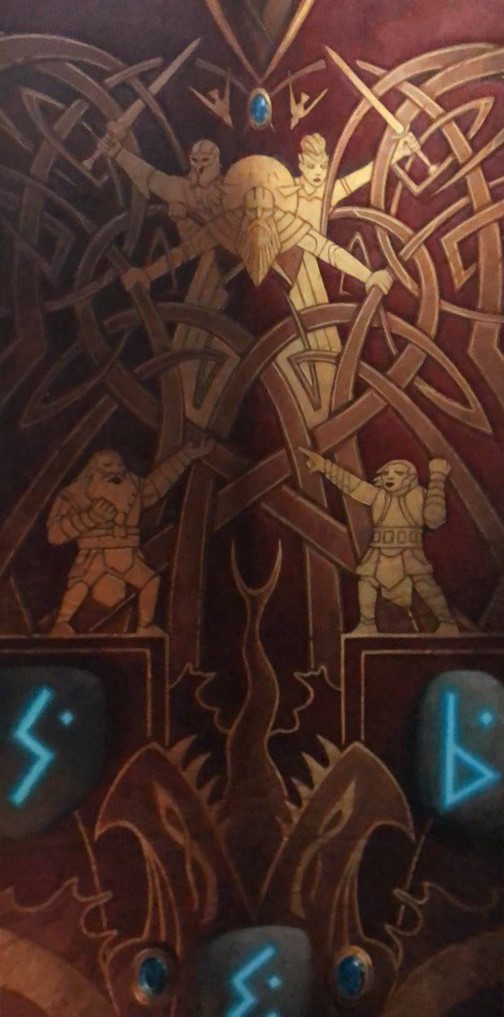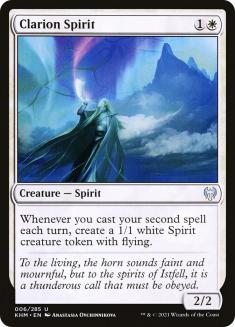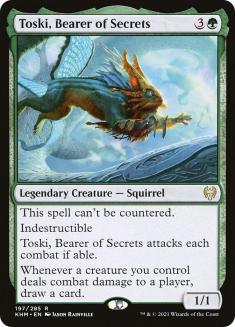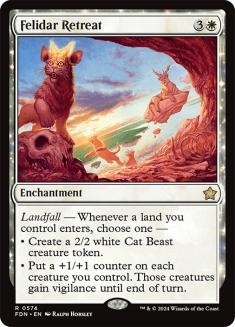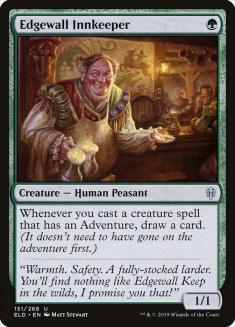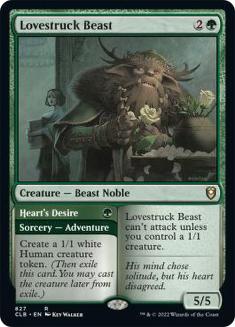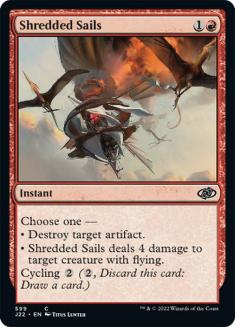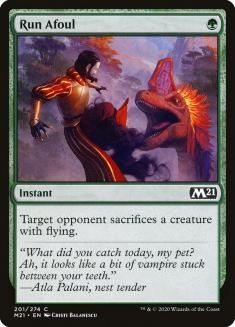Today I’ll be talking about what I believe is likely to be one of the strongest decks in the environment for Week 1 of Kaldheim Standard.
This weekend I got to dip my toes into the new Standard format for the first time on Discord with Gerry Thompson, Josh Cho, and late arrival in the evening Bryan Gottlieb. Yes, that was some aggressive name-dropping, but it’s good to be reminded that we have friends in this day and age. Reach out to your people.
Anywho, it was a lot of fun shooting the [redacted] and tuning a deck as a group; it’s been a long time since I’ve really gotten to do that. I had some ideas I wanted to explore — Naya Adventures with the heavily hyped Showdown of the Skalds was on the docket to learn about: a blend of the powerful new engine piece alongside the well-known Adventure package and a brand-new upgraded role for Shepherd of the Flock.
Some games, chats, and rapid iteration later, and here’s where the deck landed:
Creatures (29)
- 4 Lovestruck Beast
- 4 Giant Killer
- 4 Edgewall Innkeeper
- 4 Bonecrusher Giant
- 3 Shepherd of the Flock
- 2 Toski, Bearer of Secrets
- 4 Clarion Spirit
- 4 Jaspera Sentinel
Lands (17)
Spells (14)

The Broad Strokes
Before I delve into some specific card choices, let’s talk about what this deck is trying to do. Essentially, Naya Adventures leverages an absolute ton of interlocking engine-based cards and interactions and tries to stay as lean as possible.
The advantage of this over Gruul Adventures, or other Naya builds that are trying to “go bigger” with cards like The Great Henge, Embercleave, or are even trying to get greedier with more colors, is that it is more difficult for them to snowball on the battlefield and they are more reliant on A + B interactions. You can draw too many of your Throne of Eldraine artifacts without drawing a Lovestruck Beast or Kazandu Mammoth. Perhaps you’re too far behind to deploy Embercleave, or your curve is too high to truly abuse Showdown of the Skalds.
This deck can go explosively wide, putting tons of pressure on opponents, and can seamlessly kick into grinding mode, playing long games with the best of them.
As I alluded to earlier, it’s because the deck is basically all engine:
- Edgewall Innkeeper + your Adventures creatures are a well-known and proven cascading series of value.
- Showdown of the Skalds has gotten plenty of press at this point of being a pseudo-draw-four that can snowball your aggressive advantage and make overwhelming battlefields.
And now we’ve gotten to the “weird ones.”
I knew I wanted to try Clarion Spirit as it naturally plays well with the Adventure engine — you essentially get to double cast your cards and the majority of the Adventure cards are cheap and/or have a cheap mode. There’s plenty of opportunity to pick up value and go wide.
Supporting this was Jaspera Sentinel, another cheap piece of acceleration that benefits from going wide. I started with two. Two became three. Finally, to appease Gerry I played four Jaspera Sentinel to complement the final copy of Clarion Spirit.
Toski didn’t start in the maindeck. After sideboarding it in against Azorius Control and casting it on Turn 4 into four open mana with a Lovestruck Beast on the battlefield, we were pretty high on it.
It continued to overperform as it was drawn, and eventually it was the final complementary top-end to the deck. It plays beautifully with Lovestruck Beast and Clarion Spirit; Lovestruck Beast has never been better supported by a diverse cast of 1/1s.
Felidar Retreat is the final component that blends it all together – combined with Clarion Spirit, you can just never unclamp your advantage on the battlefield, even if your opponent is “going off” with their own Showdowns, Adventuring, or various other powerful components that permeate Standard. Toski is a resilient piece that can keep you at parity or ahead on cards, and your width and ability to micromanage how you push through damage with Retreat and Showdown’s Chapters 2 and 3 give you a lot of flexibility with how to pressure your opponent.
So, maybe this was just a long-winded way of stating that Clarion Spirit and Toski, Bearer of Secrets are strong cards.
That said, despite not playing any planeswalkers, this deck reminds me quite a bit of Selesnya Tokens from a few years back. You can keep pushing your advantage, building your battlefield and generating cards, while having enough traction to make it difficult for your opponents to convert their extra cards in a way that can fully stymie your offense. While you don’t play the best from behind, many of your components like Clarion Spirit and Felidar Retreat can give you a lot of breathing space to battle back as long as you aren’t getting fully gutted by something truly over the top like Embercleave or Ugin, the Spirit Dragon.
Speaking of Ugin, that’s the clear weakness for a strategy like this. It can clean up everything you’re doing in one fell swoop, and the more that folks are moving in that direction as the metagame unfolds and potentially Yorion decks get greedier and greedier, the more this deck must take some action. There are already many nods to those strategies in the sideboard, but we’ll resume talking about that shortly.
Tips and Tricks
A few things to note quickly. First, this deck’s mana is not very good. While your sources are “fine” mathematically, the fact that you have almost no true two-color lands, that is cards that can tap for A or B, means that you’ll be frequently assembling ABC mana in the first handful of turns.
The direct implications for this in terms of deck tuning is that you want to avoid double-pip cards as much as possible. There are only a couple of Questing Beasts hanging out for now.
You’re also mana-hungry and want to be as explosive as possible in the opening turns. The Temple of Plenty kind of sucks, but I think it gets the math into the right place. You have to be very careful with sequencing your lands. You likely want to have double white when given your first choice to do so, as it helps to set up sequences of casting spells and defending your position with Shepherd of the Flock.
Speaking of, in a pinch you can use Shepherd of the Flock to reset your lands if your draw was especially messy, rebuy your Shatterskull Smashing in the late-game, or simply generate a Felidar Retreat trigger. It’s a very flexible card even beyond saving your creatures and picking up your Showdown of the Skalds.
Sequencing your spells with Clarion Spirit in the mix can be very tricky too. Generally you want to cast your Jaspera Sentinels as often as possible, for obvious reasons, but with an opening hand of:
You may want to avoid casting anything until Turn 3. Running your aforementioned engine creatures into the commonly played Bonecrusher Giant sucks, and your common line of Turn 3 Clarion Spirit, Heart’s Desire, generate a token; Turn 4 Edgewall Innkeeper, Lovestruck Beast, generate a token does plenty to give you catch-up power, go super-wide, and maximize the value of your cards.
That said, it’s all a case-by-base basis and you need to be flexible. Generally, I like just generating cards with Edgewall Innkeeper as quickly as I can — casting Giant Killers and Shepherds without adventuring them unless they’re at a premium. Not only does it generate velocity, but getting bodies onto the battlefield maximizes your threat of Toski on Turn 4.
To that point, you basically want to dump your bodies as quickly as possible in the first three to four turns of the game. Generating as much battlefield presence as possible for the aforementioned legendary Squirrel, but you also often want to cast Showdown of the Skalds on Turn 5 instead of Turn 4. This will frequently net you a land drop (and often two) and give you the biggest battlefield possible on Turn 6 with the +1/+1 counter chapter available.
Of course, there are no hard and fast rules, but typically you’re playing for these big turns from Turns 4-6. Felidar Retreat can apply to the majority of examples with Showdown of the Skalds. Getting immediate value from it Turn 5 is ideal due to Binding the Old Gods being a strong Kaldheim inclusion, and it’s even better if you can convert a Fabled Passage on that turn for a double trigger.
Sideboarding
I’m not going to offer hard guides for matchups at this juncture, but rather largely talk about the problems that the current sideboard is trying to solve and the issues you should be keeping an eye out for as the initial metagame starts to evolve.
As I’ve noted, Naya Adventures is very good at getting ahead early, and is able to scrap with wide battlefields and close at a fast clip that helps to eliminate some of the extreme long-term advantages some decks have with The Great Henge.
Your primary weaknesses are getting behind and getting smacked with Embercleave, or getting swept repeatedly by control decks that can land an Ugin before you get over the finish line. Further, there are a lot of decks early on incorporating Archon of Sun’s Grace, and Goldspan Dragon is one of the strongest cards out of Kaldheim.
Shredded Sails is here to solve many of those problems, giving you a reasonable card to play against Glass Casket + Archon control or Goldspan Dragon / Throne of Eldraine artifact decks. It’s even passable against Dimir Rogues.
Run Afoul is the strongest answer to Goldspan Dragon in the format, as it dodges the protection setups with Lofty Denial out of Izzet, or the intended gameplans of “attack with Dragon + interact” out of Gruul or Rakdos decks. Run Afoul can really mess up Dragon deck sequences, but we’re only playing one for now. Keep an eye on including more copies as the metagame solidifies.
Reidane is poised to be “the most underrated” card in Kaldheim. If your opponents are messing around with Snow, there’s clear disruptive value to be had there, it can’t be Bonecrushed, and its backside is excellent against go-wide aggressive red decks. On top of all that utility is the ability to delay sweepers, Showdown of the Skalds, or the Throne of Eldraine artifacts in the pseudo-mirrors, and keep Ugin off the battlefield for a few critical turns.
Yes, it really does a lot. It’s possible that it should just be a maindeck card, but for now I prefer to keep the deck as linear and synergistic as possible.
Despite all of that utility, it isn’t necessarily at its best in sideboard matchups if your opponents are naturally incentivized to be playing cheap interaction, so don’t consider it a true panacea, particularly against Gruul Adventures.
Robber of the Rich, Klothys, and Questing Beast are essentially the anti-control / Yorion / Ugin trio. The goal is to extend early, deal some damage, force a sweeper and then get over the finish line with the aforementioned cards, backed up by Reidane, before they can bury you. These decks typically aren’t good at gaining life, making Klothys an effective squeeze as long as it can finish them before the full Ugin clear (making it an effective duo with Reidane).
The Sorcerous Spyglass certainly isn’t something I’m excited to play with, but Ugin is seriously Naya Adventures’s primary weakness.
So What Am I Looking to Cut for Then?
The mantra to follow is that sideboard games typically go net longer and are more interactive. This means that your linears like Clarion Spirit and Jaspera Sentinel get weaker, especially as more sweepers are involved. Generally my rule with mana creatures or high-synergy cards is that I’d be comfortable drawing one, but not two, and shave as adequate. Given the amount of cards that we’re bringing in against control, I’d shave down to one Sentinel and two Clarion Spirit.
As a rule, Felidar Retreat and Toski are weaker on the draw in matchups more concerned with battlefield position, but they’re still important to the deck — if you over-cut your engine pieces for interaction, you can end up in spots where you aren’t able to leverage being ahead and can get closed out by someone’s powerful artifact.
As decks evolve over the coming weeks, the key questions to ask are, “What types of cards can I put into my deck that keep its identity relatively intact while also solving the common problems I’ll face? What are the linchpins of my opponent’s deck and how do they snowball?”
Do that and you’ll be well-rewarded by playing a powerful synergistic strategy like Naya Adventures.

